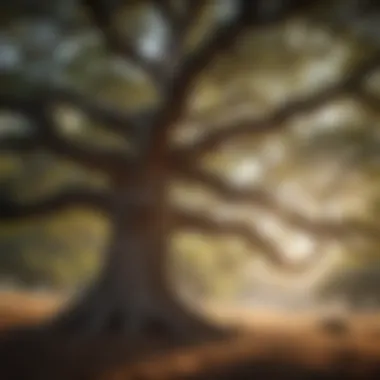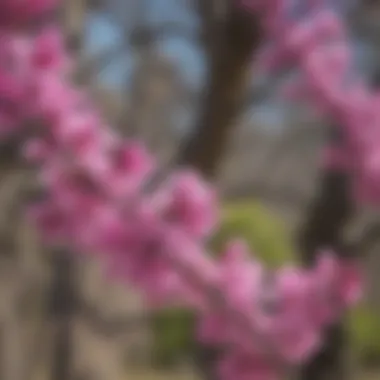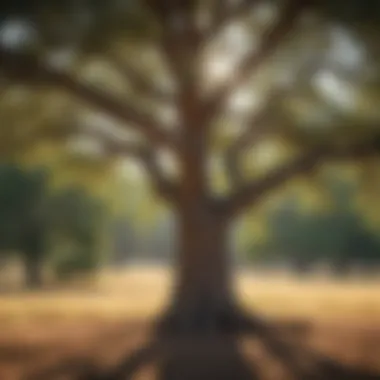Discovering Diverse Trees Perfect for Central Texas Landscapes


Good Trees to Explore in Central Texas
Tree Species Overview
Central Texas offers a diverse range of tree species suitable for landscaping, taking into account the regional climate, soil conditions, and visual appeal. When considering which trees to cultivate in this region, it is essential to understand the unique characteristics of each species to make informed decisions that align with both aesthetic preferences and environmental adaptability.
Climate and Soil Adaptability
The suitability of tree species for Central Texas is intricately linked to the local climate and soil conditions. Some trees thrive in the hot, arid climate of Central Texas, while others may struggle to survive without proper care and maintenance. Understanding the specific requirements of each tree species in relation to sunlight exposure, water needs, and soil composition is crucial for successful tree cultivation in this region.
Environmental Impact and Benefits
Selecting the right tree species for Central Texas not only enhances the visual appeal of landscapes but also contributes to crucial environmental benefits. Trees play a vital role in mitigating the urban heat island effect, improving air quality, and providing habitat for wildlife. By choosing native or adaptive tree species, individuals can create sustainable and biodiverse landscapes that support local ecosystems and promote environmental resilience.
Popular Tree Species for Central Texas
Oak Trees
Known for their strength and resilience, oak trees are a popular choice for Central Texas landscapes. With their distinctive lobed leaves and sturdy branches, oak trees provide ample shade and visual appeal. Varieties such as the Texas Red Oak and Live Oak are well-suited to the region, exhibiting adaptability to the local climate and soil conditions.
Mesquite Trees
Mesquite trees are well-adapted to the arid conditions of Central Texas, thriving in sandy soils and requiring minimal water once established. These drought-tolerant trees feature intricate foliage and provide valuable shade, making them a practical and attractive option for landscaping in the region.
Texas Mountain Laurel
Valued for its fragrant purple blooms and evergreen foliage, the Texas Mountain Laurel adds a touch of elegance to Central Texas landscapes. This slow-growing tree is native to the region and flourishes in well-drained soil with ample sunlight. Its ornamental flowers and compact size make it a popular choice for residential yards and garden spaces.


Crape Myrtle
Celebrated for its vibrant summer blooms ranging from white to pink and purple, the Crape Myrtle is a colorful addition to Central Texas landscapes. This deciduous tree thrives in full sunlight and well-drained soil, showcasing unique peeling bark and multiple trunks. With its low maintenance requirements and seasonal blooms, the Crape Myrtle provides year-round visual interest and beauty.
Closure
Exploring the variety of tree species suitable for Central Texas reveals a tapestry of options that cater to different preferences and environmental considerations. By selecting trees that excel in the regional climate and soil conditions, individuals can create resilient and picturesque landscapes that harmonize with the natural beauty of Central Texas.
Foreword
Central Texas, with its unique climate and soil conditions, presents a captivating canvas for landscaping enthusiasts to explore a diverse range of tree species. The selection of trees is a crucial decision, shaping not only the aesthetic appeal of outdoor spaces but also influencing the local ecosystem's health. By understanding the particular requirements and benefits associated with choosing the right trees for Central Texas, individuals can create sustainable and visually pleasing environments that offer refuge to local flora and fauna. This section will delve into key aspects such as climate adaptation, soil considerations, and the functional and visual appeal of trees in this region, laying the foundation for an insightful exploration of tree selection in Central Texas.
Understanding the Importance of Choosing the Right Trees
In the realm of landscaping, the significance of selecting appropriate trees cannot be overstated. Central Texas, characterized by its arid climate and unique soil composition, demands careful consideration when identifying tree species that can thrive in such conditions. Opting for trees that are well-suited to the local climate not only ensures their survival but also minimizes the need for extensive maintenance and resource input. Moreover, selecting the right trees can contribute significantly to the overall biodiversity of the area, attracting native wildlife and fostering a sustainable ecological balance. This section will delve deeper into the rationale behind choosing climate-appropriate trees for Central Texas, shedding light on the interconnectedness between tree selection, environmental health, and landscape aesthetics.
Climate-Adapted Trees
Central Texas presents a unique, challenging climate that demands thoughtful consideration when selecting trees for landscaping. The arid conditions and sizzling temperatures call for trees that can thrive in this harsh environment. Choosing climate-adapted trees is not just a matter of aesthetics but of practicality and sustainability. These trees are equipped to withstand the scorching heat and minimal rainfall that defines Central Texas, offering enduring beauty and ecological benefits to the landscape.
Drought-Tolerant Tree Species
Live Oak
Live Oak, known for its sturdiness and resilience, stands out as a premier choice for Central Texas landscapes. Its iconic spreading canopy provides excellent shade, while its ability to endure extended periods of drought without faltering makes it a top contender for this region. The Live Oak's lush green foliage, dense growth habit, and tolerance to various soil types further enhance its desirability, making it a quintessential addition to landscapes seeking beauty and adaptability.
Cedar Elm
Cedar Elm's adaptability to a range of soil conditions and its capacity to thrive in hot, dry climates make it a versatile option for Central Texas. With its graceful, vase-shaped form and serrated deep green leaves, Cedar Elm adds a touch of elegance to any landscape. Its resistance to pests and diseases adds to its allure, making it a reliable choice for those looking to enhance their outdoor spaces with a tree that marries beauty with hardiness.


Pecan
Pecan trees, with their majestic height and broad canopy, offer more than just aesthetic appeal in Central Texas. Their ability to endure drought conditions while producing delicious nuts positions them as multifunctional additions to the landscape. Pecans not only provide shade and visual interest but also contribute to the region's ecosystem by attracting wildlife. However, their large size and the maintenance required for nut production are factors to consider when incorporating Pecan trees into landscaping projects.
Heat-Resistant Trees for Central Texas
Texas Mountain Laurel
With its fragrant purple flowers and glossy green foliage, the Texas Mountain Laurel thrives in the intense Texas heat. This evergreen beauty not only adds visual charm to landscapes but also offers a delightful aroma. Its drought resistance and adaptability to various soil types further cement its status as a sought-after tree for Central Texas, providing homeowners with a low-maintenance yet stunning option for their outdoor spaces.
Mexican Plum
Mexican Plum, with its early spring blooms of white flowers and edible fruit, is an excellent choice for Central Texas landscapes. Its tolerance to heat and dry conditions, coupled with its attractive aesthetic qualities, make it a popular selection for those seeking beauty and functionality in their yards. While Mexican Plum requires minimal maintenance once established, its potential for suckering may warrant occasional pruning to maintain its desired shape.
Crape Myrtle
Crape Myrtle's vibrant summer blooms in an array of colors bring a pop of color to Central Texas gardens. Their distinctive smooth bark exfoliates to reveal a mottled pattern, adding winter interest to the landscape. Their adaptability to both heat and drought, coupled with their long flowering season, make Crape Myrtles a favored choice for adding visual impact and seasonal variations to outdoor spaces. However, their tendency to attract aphids and mildew may require vigilant monitoring and preventive measures to ensure their continued health and beauty.
Soil Considerations
In this intricate analysis of trees for Central Texas, soil considerations emerge as a pivotal factor determining the survival and vitality of trees in the region. The soil composition profoundly influences the growth, root development, and nutrient uptake of trees. Selecting tree species compatible with Central Texas soil characteristics ensures long-term sustainability and flourishing landscapes. Key aspects to ponder include soil pH levels, drainage capacity, and nutrient content. By delving into the nuances of soil considerations, one can cultivate a profound appreciation for the interconnectedness between trees and their underlying soil environments.
Trees Thriving in Central Texas Soil
Bald Cypress
Bald Cypress stands out as a resilient and majestic tree species that thrives exceptionally well in Central Texas soil. Its remarkable adaptability to varying soil conditions, including both dry and wet environments, makes it a popular choice for landscaping projects. The key characteristic of Bald Cypress lies in its ability to flourish near water, thanks to its root structure that can withstand occasional flooding. Despite its preference for waterlogged areas, Bald Cypress exhibits a remarkable tolerance for drought, enhancing its versatility in Central Texas landscapes. Additionally, the unique feature of its deciduous nature provides seasonal interest, with color changes in fall adding aesthetic value to the surroundings.
Desert Willow


Desert Willow emerges as another standout tree suited to the soil conditions of Central Texas. Its resilience in arid climates and sandy soils makes it a valuable addition to landscaping projects in the region. The key characteristic of Desert Willow lies in its drought tolerance and heat resistance, thriving in the harsh environmental conditions prevalent in Central Texas. This quality makes it a sought-after choice for homeowners seeking low-maintenance yet visually appealing trees. Despite its adaptability, Desert Willow may face challenges in high-moisture environments, requiring well-drained soil to prevent root rot.
Texas Redbud
Texas Redbud showcases unique adaptability to Central Texas soil, offering stunning visuals with its vibrant pink flowers in early spring. The key characteristic of Texas Redbud lies in its ornamental value, adding a burst of color to landscapes while attracting pollinators. Its endurance in various soil types, from clay to loam, makes it a versatile option for Central Texas gardens. However, Texas Redbud may require some extra care in extreme heat conditions to prevent leaf scorch, emphasizing the importance of suitable soil moisture levels. Nevertheless, its visual appeal and adaptability make it a popular choice for enhancing the aesthetic appeal of Central Texas landscapes.
Aesthetic Appeal and Functionality
Enhancing Your Landscape with Beautiful Trees
Enhancing your landscape with beautiful trees is more than just planting greenery; it is about curating a harmonious outdoor space that reflects your taste and complements the surrounding environment. Choosing trees based on their visual appeal, seasonal variations, and compatibility with the existing flora can transform a mundane yard into a picturesque haven. From vibrant blossoms to striking foliage, each tree adds a unique touch to the landscape, creating a diverse and captivating outdoor environment.
Trees Providing Shade and Privacy
Trees play a crucial role in providing natural shade and enhancing the privacy of a property. Strategically planting trees to block direct sunlight can significantly reduce cooling costs during hot Texas summers. Additionally, trees form natural barriers that shield your space from unwanted views, creating a more intimate and secluded setting. By selecting trees with dense foliage and appropriate height, you can enjoy relaxation in the cool shade and maintain privacy within your outdoor living spaces.
Maintenance Tips for Healthy Trees
Proper maintenance is essential for ensuring the longevity and vitality of trees in Central Texas. By following these essential guidelines, you can help your trees thrive in their environment. One crucial aspect of tree maintenance is regular pruning. Pruning not only promotes healthy growth but also prevents diseases and pest infestations. It is recommended to prune your trees during the dormant season to minimize stress on the tree. Additionally, watering plays a vital role in tree health. For Central Texas, where drought conditions are common, deep watering is preferable to promote deep root growth and resilience. Monitoring soil moisture levels and adjusting watering frequency accordingly is key to preventing both under and over-watering.
Pruning and Watering Guidelines
When it comes to pruning your trees in Central Texas, it is important to focus on removing dead, diseased, or crossing branches. Proper pruning techniques contribute to the overall health and aesthetics of the tree. Start by inspecting the tree and identifying branches that need to be pruned. Always use sharp, clean tools to make precise cuts to minimize damage. As for watering guidelines, it is crucial to water deeply and infrequently to encourage deep root growth. Newly planted trees require more frequent watering until established, after which you can transition to a deep watering schedule. Mulching around the base of the tree helps retain moisture and regulate soil temperature.
Dealing with Common Tree Issues
Trees in Central Texas face various challenges, including pests, diseases, and environmental stressors. Identifying common tree issues early on can prevent them from escalating. Look out for signs of insect infestations, such as holes in leaves or oozing sap, and act promptly with appropriate treatments. Diseases like anthracnose and oak wilt are prevalent in the region and necessitate proactive management. Environmental stress factors like poor soil drainage or improper planting techniques can also affect tree health. Consulting with a local arborist can provide valuable insights and solutions to address these issues effectively.
Ending
As we conclude this comprehensive guide on good trees for Central Texas, it is vital to recognize the pivotal role that native trees play in not only enhancing the aesthetic appeal of landscapes but also in promoting ecological sustainability. By embracing native trees, individuals can significantly contribute to the preservation of local biodiversity while requiring minimal maintenance and resources. Moreover, native trees are inherently adapted to thrive in the specific climatic conditions of Central Texas, ensuring their longevity and resilience against environmental stressors. When selecting trees for landscaping projects, prioritizing native species can establish a harmonious balance between environmental conservation and personal enjoyment, creating a symbiotic relationship between nature and human habitation.
Embracing the Beauty of Native Trees in Central Texas
In Central Texas, the beauty of native trees transcends mere visual appeal, embodying a deep-rooted connection to the region's natural heritage. By embracing and planting native tree species, individuals actively participate in the preservation of indigenous flora, fostering a sense of stewardship towards the local environment. Native trees exhibit remarkable adaptability to the climatic nuances of Central Texas, showcasing resilience and endurance in the face of droughts and heat waves. Furthermore, these trees provide essential habitats for native wildlife, supporting intricate ecosystems that rely on the presence of specific tree species for sustenance and shelter. Embracing the beauty of native trees not only enriches the visual landscape but also cultivates a profound appreciation for the unique ecological tapestry of Central Texas.







